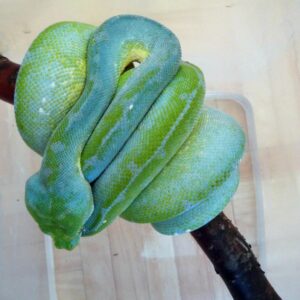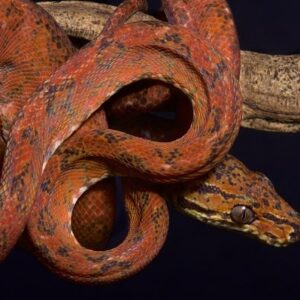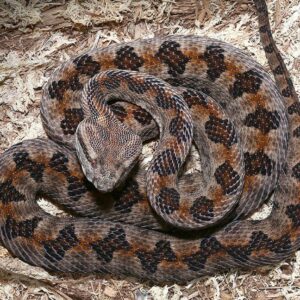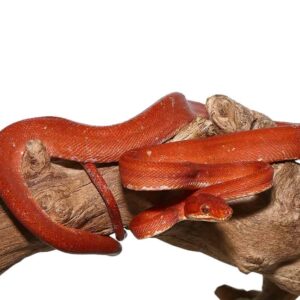Black Devil Boa For Sale
$700.00
Black Devil Boa
The Black Devil Boa is the perfect addition to any collection! This big snake can grow up to 10 feet long and stands out because of its dark brown or black body and reddish-brown tail. Not only is this snake fascinating to look at, but it also has some great benefits that make it a desirable pet. For one, the Black Devil Boa is incredibly docile and easy to take care of.
Description
The Black Devil Boa, scientifically known as Boa constrictor imperator, is a captivating species within the broader family of boas. It belongs to the Boidae family, which encompasses a diverse group of non-venomous, constricting snakes. Native to Central America, the Black Devil Boa is primarily found in the dense, tropical forests stretching from Mexico to Colombia. This unique habitat provides the ideal environment for the species, characterized by high humidity, a warm climate, and abundant vegetation.
One of the most striking features of the Black Devil Boa is its distinctive coloration. Unlike its more commonly recognized relatives, the Black Devil Boa exhibits a deep, almost jet-black hue that has intrigued both amateur herpetologists and seasoned researchers alike. This pigmentation is not merely for aesthetic appeal; it plays a crucial role in the snake’s camouflage within its shadowy, forested environment, aiding in both predation and evasion from potential threats.
The Black Devil Boa’s enigmatic nature extends beyond its appearance. Its behavioral patterns and ecological role contribute to its mystique. Known for its nocturnal habits, the Black Devil Boa is a solitary hunter, relying on its acute sense of smell and heat-sensitive pits to locate prey. These adaptations make it a formidable predator within its ecosystem, capable of subduing a variety of prey, ranging from small mammals to birds.
This species also holds significant value in scientific research. Its unique physiological traits, such as its reproductive strategies and resistance to certain diseases, offer valuable insights into the broader field of herpetology. For enthusiasts, the Black Devil Boa represents not just a pet, but a window into the intricate and often hidden world of reptiles.
In summary, the Black Devil Boa stands out as a remarkable specimen within the boa family. Its distinctive coloration, fascinating behavioral traits, and ecological significance make it a subject of continuous interest and study. This guide aims to delve deeper into the various aspects of the Black Devil Boa, shedding light on what makes this species truly exceptional.
Physical Characteristics
The Black Devil Boa, a highly intriguing species within the boa family, exhibits a unique and captivating physical appearance. Typically, these boas range in size from 4 to 6 feet in length, making them relatively moderate in comparison to other larger boa species. Their weight can vary, but they generally maintain a robust and muscular build that is characteristic of boas.
The coloration of the Black Devil Boa is perhaps its most striking feature. As its name suggests, this boa species showcases a predominantly black or dark gray hue, which can sometimes have a subtle iridescence under certain lighting conditions. This dark coloration provides the Black Devil Boa with excellent camouflage in its natural habitat, aiding in its ambush predatory lifestyle. The scales themselves are smooth and glossy, contributing to the snake’s sleek and menacing appearance.
In terms of scale pattern, the Black Devil Boa displays a uniform coloration with minimal patterning, which distinguishes it from other boa species that often have more pronounced markings. This lack of noticeable patterning adds to the mystique and enigma surrounding the species. However, some individuals may exhibit faint, darker blotches along their bodies, which can become more visible when the snake is in motion.
Sexual dimorphism is present in the Black Devil Boa, albeit subtly. Females tend to be slightly larger and more robust than males, which is common among many snake species. This size difference is particularly evident during the breeding season, as females require more body mass to support egg development.
When compared to other boa species, the Black Devil Boa’s distinctive coloration and relatively uniform scale pattern set it apart. For instance, the Red-tailed Boa exhibits a more vibrant color palette with distinct tail markings, whereas the Black Devil Boa maintains a more subdued and enigmatic appearance. This unique combination of physical traits makes the Black Devil Boa a fascinating subject of study and a coveted species among reptile enthusiasts.
Natural Habitat and Distribution
The Black Devil Boa, an enigmatic species within the boa family, thrives in some of the most diverse and complex ecosystems on the planet. Predominantly found in the tropical regions of South America, its distribution spans across countries such as Brazil, Peru, and parts of Colombia. These areas offer the ideal environment for the Black Devil Boa, providing the necessary climatic and ecological conditions for its survival.
Primarily, the Black Devil Boa inhabits the dense, humid rainforests that characterize much of its range. The tropical climate, marked by high humidity and consistent temperatures averaging between 25-30°C (77-86°F), creates a perfect habitat. These conditions facilitate the boa’s physiological processes and contribute to its overall well-being. The dense canopy of the rainforest offers ample cover and hunting opportunities, essential for a species that relies heavily on camouflage and stealth to secure its prey.
Additionally, the Black Devil Boa is often found near water bodies such as rivers and streams, which are abundant in its natural habitat. These water sources are crucial, not only for hydration but also as hunting grounds where the boa can ambush unsuspecting prey. The presence of a varied and abundant prey base, including small mammals, birds, and amphibians, further underscores the importance of these ecosystems for the boa’s survival.
Beyond the rainforests, the Black Devil Boa can also adapt to secondary forests and areas of human encroachment, provided that these environments still offer sufficient cover and prey availability. However, it is the undisturbed primary forests that offer the optimal conditions for this species, highlighting the critical need for conservation efforts in these areas to ensure the survival of the Black Devil Boa.
Understanding the natural habitat and distribution of the Black Devil Boa is essential for its conservation. Protecting its natural environments from deforestation and habitat fragmentation is crucial to maintaining the ecological balance and ensuring the continued existence of this fascinating species.
Diet and Hunting Behavior
The Black Devil Boa, a remarkable serpent, exhibits specialized dietary and hunting behaviors that set it apart within its ecosystem. This predominantly nocturnal predator primarily feeds on small mammals, birds, and occasionally reptiles. Its diet is heavily influenced by the availability of prey in its habitat, adapting to seasonal changes and local ecological conditions. The flexibility in its diet ensures the boa’s survival across various environments.
Hunting primarily at night, the Black Devil Boa employs a combination of stealth and power to capture its prey. Utilizing its exceptional camouflage, it lies in wait, blending seamlessly with its surroundings until an unsuspecting animal ventures close. When the moment strikes, the boa uses rapid constriction to immobilize and suffocate its prey. This ambush strategy is highly effective, allowing the boa to conserve energy and increase its success rate.
In terms of frequency, the Black Devil Boa does not require daily feeding. Depending on the size of the meal, it can go several weeks between feedings. Larger prey can sustain the boa for longer periods, providing it with necessary nutrients while minimizing the need for constant hunting. This infrequent feeding schedule is a crucial adaptation, reducing the risk of exposure to potential threats.
One of the Black Devil Boa’s unique adaptations is its highly sensitive heat-sensing pits located along its jawline. These pits allow the boa to detect the infrared radiation emitted by warm-blooded prey, giving it a significant advantage in low-light conditions. This adaptation is particularly beneficial for nighttime hunting, enhancing the boa’s ability to locate and capture prey efficiently.
Overall, the dietary habits and hunting techniques of the Black Devil Boa reflect a finely tuned balance of energy conservation and predatory efficiency. Its ability to adapt to varying prey availability and environmental conditions underscores the evolutionary success of this enigmatic creature. By understanding these behaviors, we gain deeper insights into the ecological role of the Black Devil Boa and the intricate web of life within its habitat.
Reproduction and Lifespan
The reproductive cycle of the Black Devil Boa is a fascinating process characterized by unique behaviors and biological intricacies. During the mating season, which typically occurs once a year, males engage in combat with rivals to win the favor of a receptive female. This combat involves intertwining their bodies and attempting to overpower each other. Once a male has successfully mated with a female, the gestation period begins, lasting approximately 140 to 160 days. This relatively long period is an adaptation that ensures the offspring are born at a time when environmental conditions are most favorable for their survival.
The birthing process in Black Devil Boas is viviparous, meaning the female gives birth to live young rather than laying eggs. A single litter can consist of anywhere between 10 to 30 neonates, each measuring around 12 to 18 inches in length. Post-birth, the mother does not provide any parental care, and the young are immediately independent. They must fend for themselves from the moment they are born, relying on their instinctive behaviors to find food and avoid predators.
When it comes to lifespan, the Black Devil Boa exhibits notable differences between individuals in the wild and those in captivity. In the wild, these boas face numerous threats such as predation, habitat loss, and varying environmental conditions, which can reduce their average lifespan to about 15 to 20 years. Conversely, in captivity, where they are provided with a controlled environment, regular feeding, and medical care, Black Devil Boas can live significantly longer, often reaching up to 25 to 30 years. Factors such as diet, habitat quality, and stress levels play crucial roles in influencing their longevity. Proper care and management are therefore essential for maximizing their lifespan in captivity.
Behavior and Temperament
The Black Devil Boa, known for its mystique and intriguing behavior, exhibits a primarily nocturnal lifestyle. This species is most active during the night, leveraging the cover of darkness to hunt and explore its environment. During daylight hours, it tends to seek refuge in shaded, concealed areas to avoid the heat and potential predators. The Black Devil Boa’s nocturnal nature is a key aspect of its behavior, influencing its feeding habits and interactions within its habitat.
In terms of social structure, the Black Devil Boa is generally solitary. It prefers to live and hunt alone, only interacting with others of its kind during mating season. This solitary behavior is typical of many boa species and is essential for their survival, as it reduces competition for resources such as food and shelter. When encountering other species, the Black Devil Boa’s behavior can vary. While it is not inherently aggressive, it will defend itself if threatened, using its powerful constriction ability to subdue potential threats.
The temperament of the Black Devil Boa in relation to human handling is another crucial aspect to consider, especially for those interested in keeping one as a pet. Generally, the Black Devil Boa is known for its calm demeanor when properly socialized and accustomed to human interaction. It can be quite docile and manageable, making it a suitable choice for experienced snake handlers. However, like all wild animals, individual temperaments can vary, and it’s important to approach handling with respect and caution.
In captivity, the Black Devil Boa can thrive with appropriate care. Its enclosure should replicate its natural habitat as closely as possible, with adequate hiding spots and a temperature gradient to accommodate its nocturnal activity patterns. Regular handling and gentle interaction from a young age can help in maintaining a docile temperament. Understanding the behavior and temperament of the Black Devil Boa is essential for ensuring its well-being in both wild and captive environments, highlighting the importance of species-specific knowledge in reptile care.
Conservation Status and Threats
The conservation status of the Black Devil Boa (Boa constrictor imperator) is currently a topic of significant concern among herpetologists and conservationists. According to the International Union for Conservation of Nature (IUCN) Red List, the Black Devil Boa is not yet classified as endangered, but it is considered a species of “Least Concern.” However, this classification does not imply that the species is free from threats. In fact, the Black Devil Boa faces several critical challenges that jeopardize its survival in the wild.
Habitat destruction stands out as one of the most pressing threats to the Black Devil Boa. The deforestation of tropical rainforests for agricultural expansion, logging, and urban development has resulted in the loss of vital habitats for these reptiles. As their natural environment shrinks, Black Devil Boas are increasingly forced into smaller, fragmented areas, which undermines their ability to find food, mate, and maintain healthy populations.
Poaching and illegal wildlife trade also pose significant threats to the Black Devil Boa. These snakes are often captured and sold in the exotic pet market, where their distinctive coloration makes them highly desirable. Despite laws and regulations intended to curb such activities, illegal trade continues to thrive, exacerbating the decline in wild populations.
Climate change further compounds the challenges faced by the Black Devil Boa. Shifts in temperature and precipitation patterns can alter the ecosystems on which these snakes depend. Changes in climate can disrupt their breeding cycles, reduce the availability of prey, and increase susceptibility to diseases. The cumulative impact of these factors can lead to a decline in population numbers over time.
Conservation efforts are underway to mitigate these threats and safeguard the future of the Black Devil Boa. Organizations and research institutions are working to preserve their habitats through protected areas and reforestation projects. Anti-poaching initiatives and stricter enforcement of wildlife trade regulations aim to reduce illegal activities. Additionally, climate change mitigation strategies are being explored to ensure long-term ecological stability.
In conclusion, while the conservation status of the Black Devil Boa is currently stable, the species faces numerous threats that require concerted efforts to address. Through habitat protection, anti-poaching measures, and climate resilience strategies, it is possible to secure a sustainable future for these enigmatic reptiles.
Care in Captivity
Proper care for the Black Devil Boa in captivity is crucial to ensure its health and well-being. Setting up an appropriate enclosure is the first step. A spacious terrarium, measuring at least 4 feet by 2 feet, is recommended for an adult Black Devil Boa. The enclosure should be secure, well-ventilated, and escape-proof, with adequate hiding spots and branches for climbing. Substrates such as cypress mulch or coconut fiber are ideal, as they help maintain the humidity levels required for this species.
Temperature regulation is paramount. The Black Devil Boa thrives in a gradient temperature range, with a basking spot maintained at 88-92°F and a cooler area around 75-80°F. Nighttime temperatures can drop slightly but should not fall below 70°F. Using a combination of heat lamps and under-tank heaters can help achieve these gradients. Additionally, humidity levels should be kept between 60-70%, which can be managed by regular misting and using a hygrometer to monitor conditions within the terrarium.
Dietary needs of the Black Devil Boa are relatively straightforward. A diet primarily consisting of appropriately sized rodents is sufficient. Feeding frequency varies with age; juveniles may require feeding every 5-7 days, whereas adults can be fed every 10-14 days. Always ensure that the prey size is no larger than the boa’s widest point to prevent regurgitation or other digestive issues.
Health care is another critical aspect of Black Devil Boa care. Regular observation for signs of illness, such as respiratory issues, skin shedding problems, or lack of appetite, is essential. A yearly check-up with a reptile veterinarian can help catch and address potential health concerns early. Owners should also be aware of common challenges, such as ensuring the snake does not become overweight and managing stress, which can arise from improper handling or inadequate enclosure conditions.
Responsible ownership of a Black Devil Boa means understanding and meeting all its needs. This not only contributes to the snake’s physical health but also its overall quality of life. Providing the right environment, diet, and health care ensures that the Black Devil Boa can thrive in captivity, offering its owner a rewarding experience.







